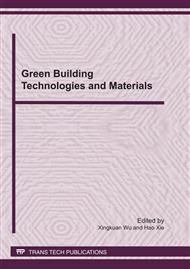[1]
G. Wang and H.W. Ma: A Study of The Formation Process of the Geopolymer gel[J]. Acta Petrologica Et Mineralogica, 2005, 24(2), pp.133-138.
Google Scholar
[2]
J.S.J. Van Deventer, J.L. Provis and P. Duxson: Reaction Mechanisms in the Geopolymeric Conversion of Inorganic Waste to Useful Products[J]. Journal of Hazardous Materials, 2007, 139, p.506–513.
DOI: 10.1016/j.jhazmat.2006.02.044
Google Scholar
[3]
V.M. Malhotra and P.K. Mehta: High-Performance, High-Volume Fly Ash Concrete for Building Sustainable and Durable Structures[M]. Supplementary Cementing Materials for Sustainable Development Inc, Ottawa, Canada (2008).
Google Scholar
[4]
J. Davidovits and M. Davidovics. Geopolymer Room Temperature Ceramic Matrix for Composites[J]. Ceram Eng Sci Proc, 1988, 9, pp.835-842.
Google Scholar
[5]
A.J. Foden, P. Balaguru and R.E. Lyon: Mechanical Properties and Fire Response of Geopolymer Structural Composites[J]. Int SAMPE Symp Exhib, 1996(41), pp.748-758.
Google Scholar
[6]
T. Bakharev: Durability of Geopolymer Materials in Sodium and Magnesium Sulfate Solutions[J]. CemConcr Res, 2005(35), p.1233–1246.
DOI: 10.1016/j.cemconres.2004.09.002
Google Scholar
[7]
Y.S. Zhang, W. Sun and L. Zhang: In Situ Quantitatively Tracking the Hydration Process of Interfacecial Transition Zone Between Coarse Aggregate and K-PSDS Geopolymer Matrix With ESEM[J]. Journal of The Chinese Ceramic Society, 2003(31), pp.806-810.
Google Scholar
[8]
L.Q. Weng, Sagoe-Cren Tsil Kwesi and S.H. Song. Hydrolysis Kinetics of Aluminates in Geopolyers Synthesis[J]. Journal of the Chinese Ceramic Society, 2005, 33(3), pp.276-280.
Google Scholar
[9]
H.F.W. Taylor: Chemistry of Cement Hydration. Proc 8th Int Congress in the Chemistry of Cement, 1986(1), pp.82-110 .
Google Scholar
[10]
M. Luz Granizo M.T. Blanco-Varela and S. Martı´nez-Ramı´rez: Alkali Activation of Metakaolins-Parameters Affecting Mechanical, Structural and Microstructural Properties[J]. J Mater Sci, 2007(42), p.2934–2943.
DOI: 10.1007/s10853-006-0565-y
Google Scholar
[11]
H. Xu and J.S.J. Van Deventer: Microstructural Characterization of Geopolymers Synthesized from Kaolinite/stilbite Mixtures Using XRD, MAS-NMR, SEM/ED, 2002(32), pp.1705-1716
DOI: 10.1016/s0008-8846(02)00859-1
Google Scholar
[12]
William K. Lee. Solid–Gel Interactions in Geopolymers[D]. The University of Melbourne, Department of Chemical Engineering, 2002, pp.147-148.
Google Scholar
[13]
J.W. Phair and J.S.J. Van Deventer. Effect of Silicate Activator pH on The Leaching and Material Characteristics of Waste-based Inorganic Polymers[J]. Minerals Engineering, 2001(14), pp.289-304.
DOI: 10.1016/s0892-6875(01)00002-4
Google Scholar
[14]
A.Q. Wang and C.Z. Zhang: Formation Mechanism and Methods of Improvement of Interfacecial Transition Zone between Cement Paste and Aggregate[J]. Concrete and Cement Products, 1994, pp.18-20.
Google Scholar
[15]
H. Xu and J.S.J. Van Deventer: The Geopolymerisation of Alumino-Silicate Minerals[J]. Int J Miner Process, 2000(59), pp.247-266.
DOI: 10.1016/s0301-7516(99)00074-5
Google Scholar
[16]
W.K.W. Lee and J.S.J. van Deventer: The Interface between Natural Siliceous Aggregates and Geopolymers[J]. Cem Concr Res, 2004(34), pp.195-206.
DOI: 10.1016/s0008-8846(03)00250-3
Google Scholar
[17]
L. Chen, Z.H. Zheng, H.Q. Shao and Fan Pengyun: Research on Asymmetry of Interfacial Transition Zone in Concrete[J]. Journal of Wuhan University of Technology, 2007(29), pp.111-114.
Google Scholar
[18]
Y.L. Zhao: Study on the Formation of Cementitious Material and Mechanism of Hydration by Water Glass Activation of Fine Slag[D]. Xi An University of Architecture and Technology, 2007, pp.26-29.
Google Scholar


